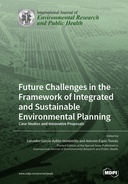Explore

Future Challenges in the Framework of Integrated and Sustainable Environmental Planning
0 Ungluers have
Faved this Work
Login to Fave
The correct management of territory and its planning based on scientific criteria in the face of the anthropogenic impacts of human activities is one of the main challenges in the 21st century. This publication includes some of the latest advancements in environmental planning and spatial analysis related to the ecological management of territory from a multidisciplinary perspective. The research papers from different researchers, scholars and experts in this field included in this collection were published by the International Journal of Environmental Research and Public Health after undergoing a rigorous anonymous peer review process.
This book is included in DOAB.
Why read this book? Have your say.
You must be logged in to comment.
Rights Information
Are you the author or publisher of this work? If so, you can claim it as yours by registering as an Unglue.it rights holder.Downloads
This work has been downloaded 100 times via unglue.it ebook links.
- 100 - pdf (CC BY) at Unglue.it.
Keywords
- 2030 Agenda
- Accessibility
- agriculture green technology diffusion
- ammonium
- analytic hierarchy process
- ANGSt method
- Barriers
- Beijing
- City planning
- Climate Change
- Coastal erosion
- copper mine tailings
- Decision-support systems
- decomposition
- decoupling analysis
- dissipative structure
- ecological capacity
- ecological footprint
- ecological restoration
- ecological security
- ecological security pattern
- economic complexity indicator (ECI)
- economic growth
- Energy consumption
- enterprise technology innovation
- entropy change
- environment-related routine
- environmental equity
- Environmental impact
- environmental planning
- Environmental policy
- environmental uncertainty
- fertilization
- Good governance
- government subsidies
- green university
- Hulunbeir grassland
- hybrid methodology
- improved coupling coordination model
- information transparency
- Integrated Coastal Zone Management
- Intersectionality
- Lancang-Mekong Cooperation (LMC)
- Land
- legislation
- migration of nitrogen forms
- mine tailing stabilization
- mining environmental liabilities
- Monitoring
- multi-criteria decision making (MCDM) methods
- natural capital utilization
- natural green space accessibility
- nitrate
- obstacle degree model
- Panel Vector Autoregression (PVAR)
- paper consumption
- People with disabilities
- plastic consumption
- policy scenario analysis
- Population
- population–resource management framework
- post-COVID-19 higher education
- public green space
- public use
- quality criteria
- Reference, information & interdisciplinary subjects
- Research & information: general
- shrinking cities
- SIMUS
- SLEUTH model
- Social network analysis
- Socio-ecological system
- spatial policy
- stakeholders
- stewardship
- STIRPAT model
- Strategic planning
- student campus
- SUMP
- Sustainable Environment
- tailing bricks
- territorial sustainability
- thema EDItEUR::G Reference, Information and Interdisciplinary subjects::GP Research and information: general
- two-stage dynamic fuzzy programming with Hurwicz criterion
- unmanned aerial vehicles (UAVs)
- urban growth simulation
- urban mobility
- Urbanization
- Virtual reality
- vulnerability assessment
- water consumption
- water resource security
- weighted sum method (WSM)
- willingness to pay
Links
DOI: 10.3390/books978-3-0365-7381-6Editions

